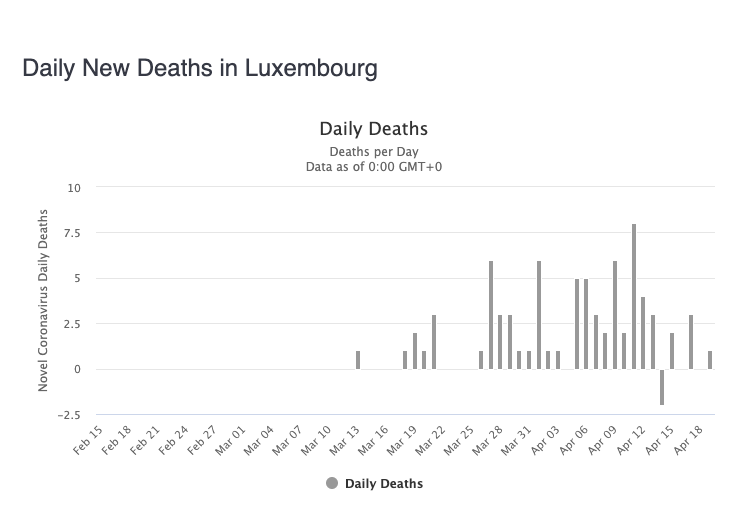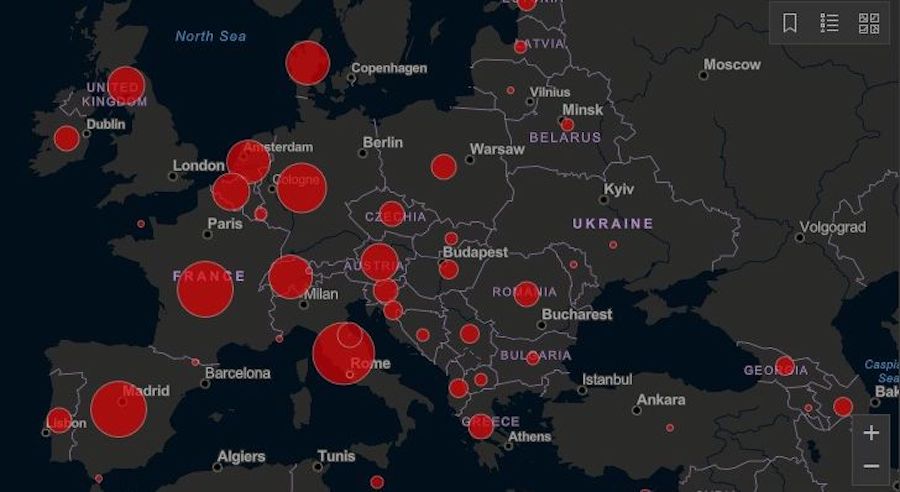Greece
Compared to Spain and Italy, Greece has reported a tiny number of cases, and all trend lines are favorable. British expat Lynne Evans, who lives in Corinth, says Greeks are taking the shutdown seriously and if they don’t, Greek officials step into enforce the restrictions.
You can read her full post here.
Greece has rapidly become a model for countries that should have been hard-hit – older population, modest healthcare system – but weren’t, learning quickly from other countries’ failings.
Greece had a recent blip in number of daily new cases, reporting 129 on 2 April, the most in a 24-hour period. That rate declined to 11 by 19 April, the lowest one-day total since 11 March.
Greece is reporting only two or three deaths in 24-hour periods as of late-April.
Greek officials announced on 22 March that the country is locked-down for the near-term. Greeks will be allowed to travel to work and back, to the grocery and to get healthcare.
But even then, you must have forms explaining the reason you’ve left your home. The Ministry of the Interior is providing online forms at: forma.gov.gr, or by text at 13033.
Greece was proactive, closing schools before most other countries in Europe. Now, the country is blocking people trying to flee to the Greek Islands from Italy. As of mid-March, Greek officials had closed just about everything, including all the museums and archeological sites/ruins. On Monday, 17 March that included all shops, with only supermarkets, pharmacies, banks, gas stations and food delivery services to remain open.
Also, everyone regardless of nationality arriving in Greece will be quarantined for 14 days.
Number of cases reported: 2,235, up an aggregate 880 percent from 228 as of 14 March
Number of deaths: 113, with a deaths-per-million of population rate of 11, far lower than even Germany
Number of patients recovered: 269, up from 19 on 22 March

Italy
The first country in Europe to be hit, Italy crossed the 100,000 total coronavirus cases mark on 30 March. As of mid-April, it’s one of the first to reopen. The government extended non-essential business closures to 3 May, but more than 100,000 mainly small- and medium-sized companies have applied to keep going or partially reopen.
The rate of new cases per day has decreased dramatically since peaking at 6,557 on 21 March. On 1 April, Bloomberg’s headline was “Europeans See Glimmer of Hope in Italy’s Virus Stabilization.”
On 4 April, Italy reported its first drop in the number of people in intensive care and on 12 April, Italy recorded its fewest daily deaths – 431 – since 19 March.
Deaths reported within a 24-hour period decreased almost 80 percent to 525 on 5 April from 919 on 27 March. Moreover, daily new cases decreased by more than 50 percent to 2,667 on 14 April from a peak of 6,557 on 21 March.
On 31 March, Italian officials announced they would slightly relax lockdown rules, allowing parents to take children for walks “close to home,” according to Bloomberg. But the lock-down rules is now extended into early May from mid-April.
Italian officials state they believe one out of every 10 people is infected, according to Reuters and Italy still isn’t out of the metaphorical woods. Marketwatch has a first-person account of life there from an expat, which you can see here.
In the post, college instructor Alison Fottrell talks about aggressive enforcement of shutdown rules – fines of up to 3,000 euros for anyone who continues to leave their house for undocumented reasons, and up to five years in prison for infected people who refuse to self-isolate.
About 9.5 percent of those infected have died, according to Marketwatch, compared to 0.4 percent in Germany. At 367 deaths per million in population, Italy now has the second-highest rate of death in Europe behind Spain at 413. By comparison, Greece is at 10 deaths per million.
Passing the 10,000 deaths mark on 28 March – three times the rate of China – Italy’s main contributing factor is the oldest population in Europe, the second oldest in the world behind Japan. The percentage of the Italian population over 65 years old is about 35 percent … the demographic most susceptible to developing severe complications from the virus. And many Italians live in extended families with grandparents, parents and children.
The week of 22 March was the worst, with Italy closing in on five times China’s total number of deaths as of 4 April, more than 15,000 in Italy to about 3,333 in China.
Italy’s response now is a Harvard Business Review case study of what can go wrong in pandemics. Piecemeal attempts at a lockdown always lagged behind the rate of infection, according to the New York Times.
Italy has taken a number of steps to ameliorate the financial impact, including declaring a moratorium on mortgage payments.
See more here on Wired about why COVID-19 has hit Italy so hard.
Number of reported cases: 178,972 as of 19 April, up an aggregate 539 percent from 28,000 as of 16 March
Number of deaths: 23,660, up an aggregate 1,542 percent from 1,441 on 14 March, or 391 deaths per one million in population, third in Europe behind Spain and Belgium.
Number of patients recovered: 47,055 up from 2,941 on 17 March

Luxembourg
Luxembourg had a few tough days in March, but the the overall coronavirus infection rate has dropped significantly to 47 new cases on 11 April from the worst 1-day total, 234 cases reported 25 March. Now, the country is slowly reopening as of 19 April.
On 4 April, Luxembourg was – as far as we can document – the first major expat center in Europe since 26 March to report no new deaths in a 24-hour period. And it’s had multiple days since then with zero deaths. Government officials are now talking about the transition from pandemic measures to normalcy.
This is a quick turnaround. Luxembourg didn’t report a confirmed case until 29 February. As of 19 April, the country had a rate of 120 deaths per each 1 million in population, far lower than its neighbors except for Germany.
Luxembourg rushed to expand its clinical footprint with new treatment centers as well as field tents courtesy of NATO to expand the main hospital, Centre Hospitalier du Luxembourg.
The European Commission approved the country’s 300 million euro package to assist companies weather the pandemic.
Number of reported cases: Luxembourg reported 3,588 confirmed cases as of 19 April from 77 cases on 15 March, an aggregate 4,560 percent increase in just over one month.
Number of deaths: 75, up an aggregate 1,500 percent from 6 deaths on 17 March. But starting 4 April, the duchy’s reported several days without deaths though its rate is 120 per million in population, roughly 2.5 times higher than Germany.
Number of patients recovered: 637 reported on 19 April, up from 40 reported as of 30 March














